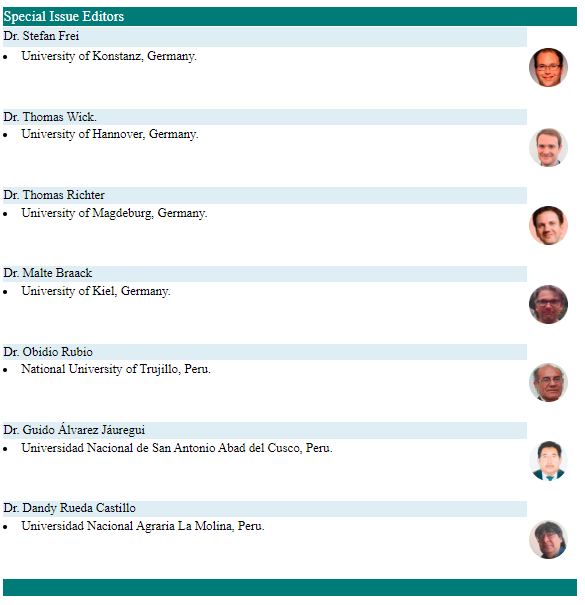Rotational gravity-capillary waves generated by a moving disturbance
DOI:
https://doi.org/10.17268/sel.mat.2021.02.02Keywords:
Water waves, gravity-capillary waves, Euler equations, conformal mappings.Abstract
Nonlinear gravity-capillary waves generated by the passage of a pressure distribution over a sheared channel with constant vorticity are investigated. The problem is modeled using the full Euler equations. The harmonic part of the velocity field is formulated in a canonical domain through the use of the conformal mapping, which flattens the fluid domain onto a strip. The Froude number is considered to be nearly-critical and the Bond number critical. The shear effect changes drastically the pattern of the generated waves for large times. Moreover, depending on the intensity of the vorticity, the wave solutions can become smoother with small amplitudes.
References
Akylas TR. On the excitation of long nonlinear water waves by a moving pressure distributions. J Fluid Mech. 1984; 141:455-466. DOI: 10.1017/S0022112084000926.
Baines P. Topographic effects in stratified flows. Cambridge: Cambridge University Press; 1995.
Johnson RS. Models for the formation of a critical layer in water wave propagation. Phil Trans R Soc A. 2012; 370:1638-1660. DOI: 10.1098/rsta.2011.0456.
Dyachenko AL, Zakharov VE, Kuznetsov EA. Nonlinear dynamics of the free surface of an ideal fluid. Plasma Phys. 1996; 22:916-928.
Falcon E, Laroche C, Fauve S. Observation of depression solitary surface waves on a thin fluid layer Phys Rev Lett. 2002;89:204501-1-204501-4.
Flamarion MV, Ribeiro-Jr R. An iterative method to compute conformal mappings and their inverses in the context of water waves over topographies Int J Numer Meth Fl. 2021; 93(11):3304-3311. DOI: 10.1002/fld.5030.
Flamarion MV, Milewski PA, Nachbin A. Rotational waves generated by current-topography interaction. Stud Appl Math. 2019; 142: 433-464. DOI: 10.1111/sapm.12253.
Flamarion MV. Rotational flows over obstacles in the forced Korteweg-de Vries framework. Selecciones Matematicas. 2021; 8(1):125-130. DOI: 10.17268/sel.mat.2021.01.12.
Flamarion MV, Ribeiro-Jr R. Gravity-capillary flows over obstacles for the fifth-order forced Korteweg-de Vries equation. J. Eng Math. 2021; 129:17. DOI: 10.1007/s10665-021-10153-z.
Fracius M, Hsu HC. Kharif C, Montalvo P. Gravity-capillary waves in finite depth on flows of constant vorticity. Proc R Soc Lond A. 2016; 472:20160363.
Grimshaw R, Maleewong M. Stability of steady gravity waves generated by a moving localized pressure disturbance in water of finite depth. Phys Fluids. 2013:25:076605. DOI: 10.1063/1.4812285.
Hanazaki H, Hirata M, Okino S. Radiation of short waves from the resonantly excited capillary-gravity waves. J. Fluid Mech. 2010;810: 5-24. DOI: 10.1017/jfm.2016.702
Milewski, PA, Vanden-Broeck JM. Time dependent gravity-capillary flows past an obstacle Wave Motion. 1999; 29:63-79.
Milewski PA. The Forced Korteweg-de Vries equation as a model for waves generated by topography. CUBO A mathematical Journal. 2004; 6:33-51.
Pratt LJ. On nonlinear flow with multiple obstructions. J Atmos Sci. 1984; 41:1214-1225. DOI: 10.1175/1520-0469.
Trefethen LN. Spectral Methods in MATLAB. Philadelphia: SIAM; 2001.
Wu TY. Generation of upstream advancing solitons by moving disturbances. J. Fluid Mech. 1987; 184: 75-99. DOI:10.1017/S0022112087002817.
Downloads
Published
How to Cite
Issue
Section
License
Copyright (c) 2021 Selecciones Matemáticas

This work is licensed under a Creative Commons Attribution 4.0 International License.
The authors who publish in this journal accept the following conditions:
1. The authors retain the copyright and assign to the journal the right of the first publication, with the work registered with the Creative Commons Attribution License,Atribución 4.0 Internacional (CC BY 4.0) which allows third parties to use what is published whenever they mention the authorship of the work And to the first publication in this magazine.
2. Authors may make other independent and additional contractual arrangements for non-exclusive distribution of the version of the article published in this journal (eg, include it in an institutional repository or publish it in a book) provided they clearly state that The paper was first published in this journal.
3. Authors are encouraged to publish their work on the Internet (for example, on institutional or personal pages) before and during the review and publication process, as it can lead to productive exchanges and to a greater and more rapid dissemination Of the published work.












